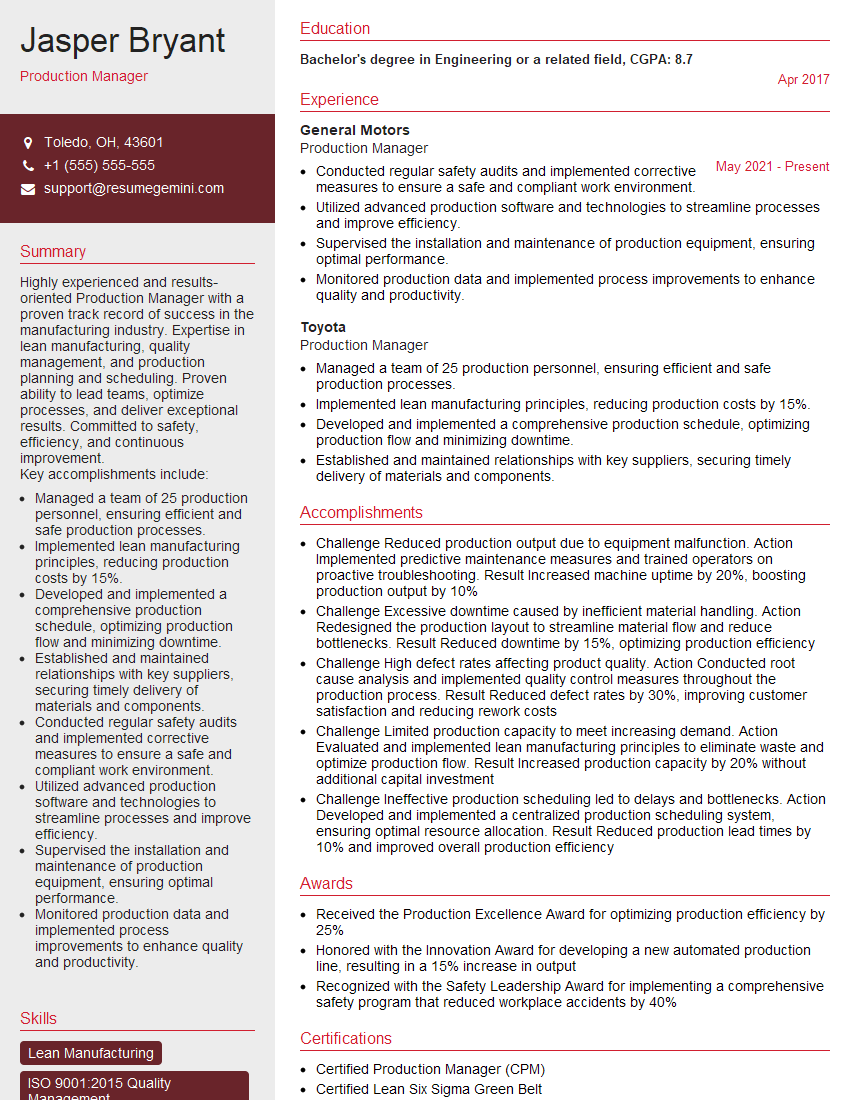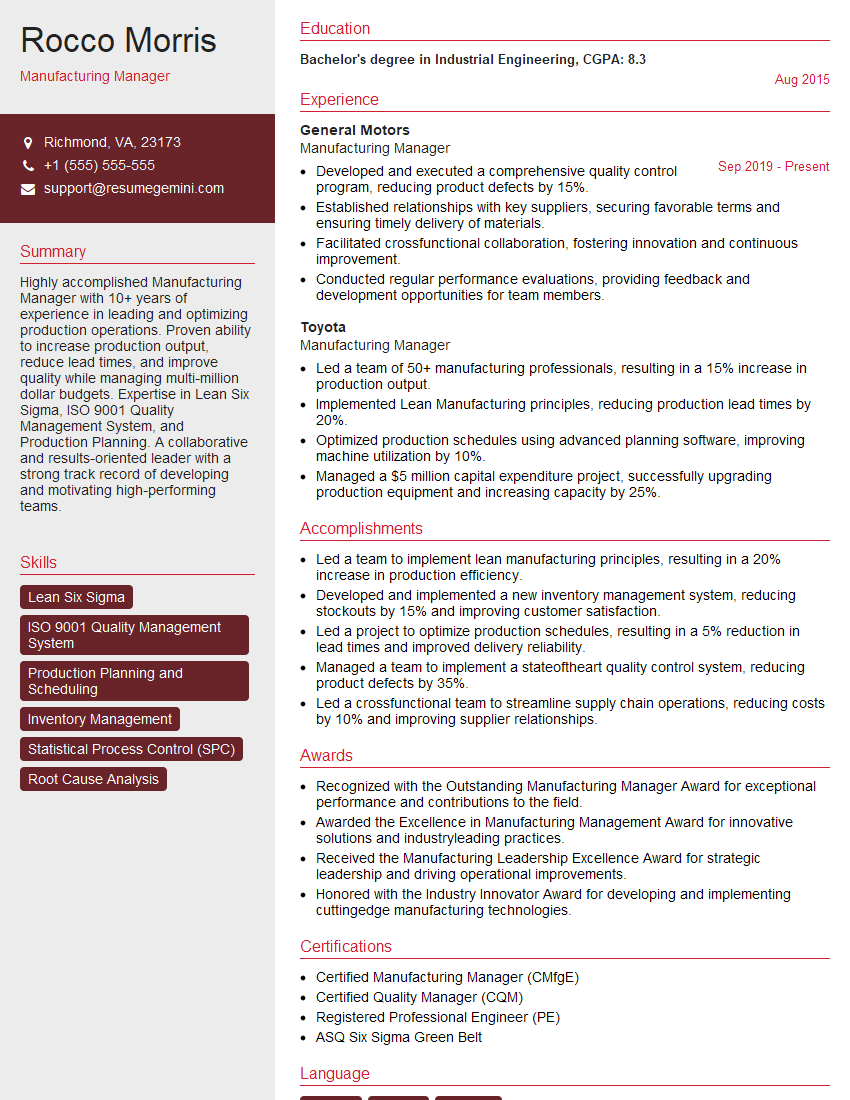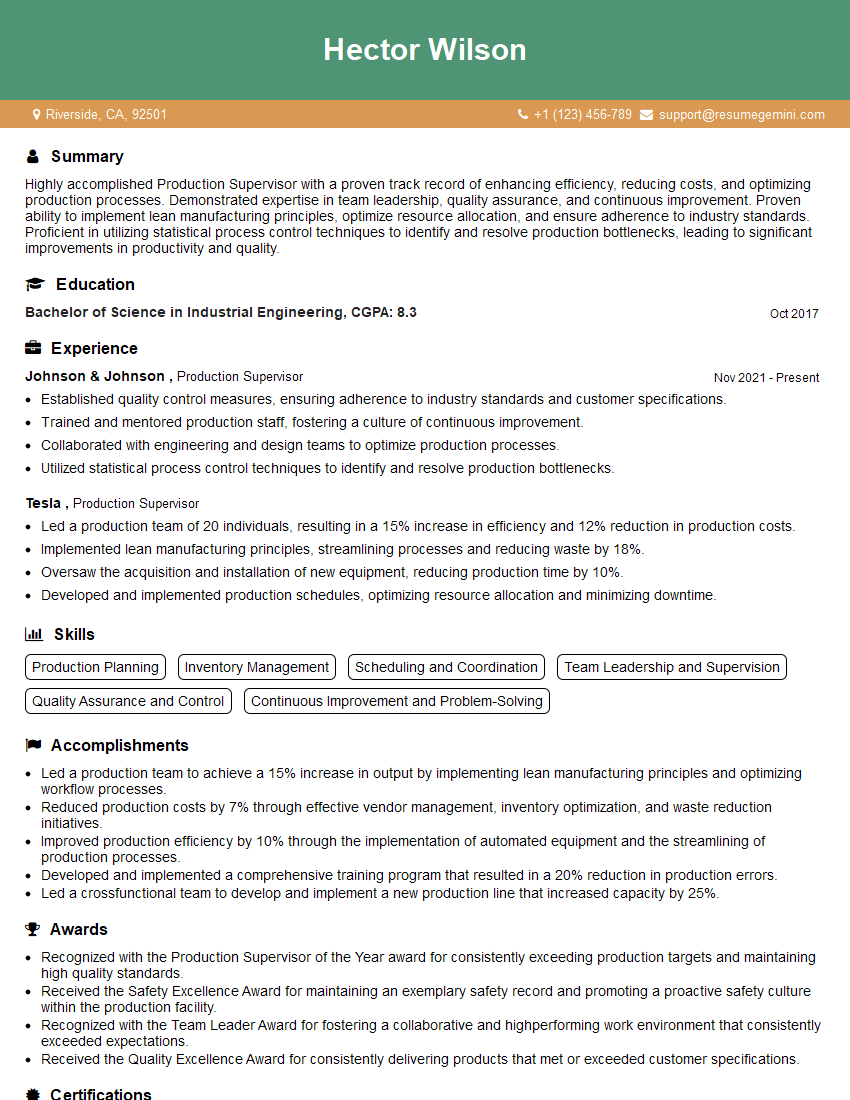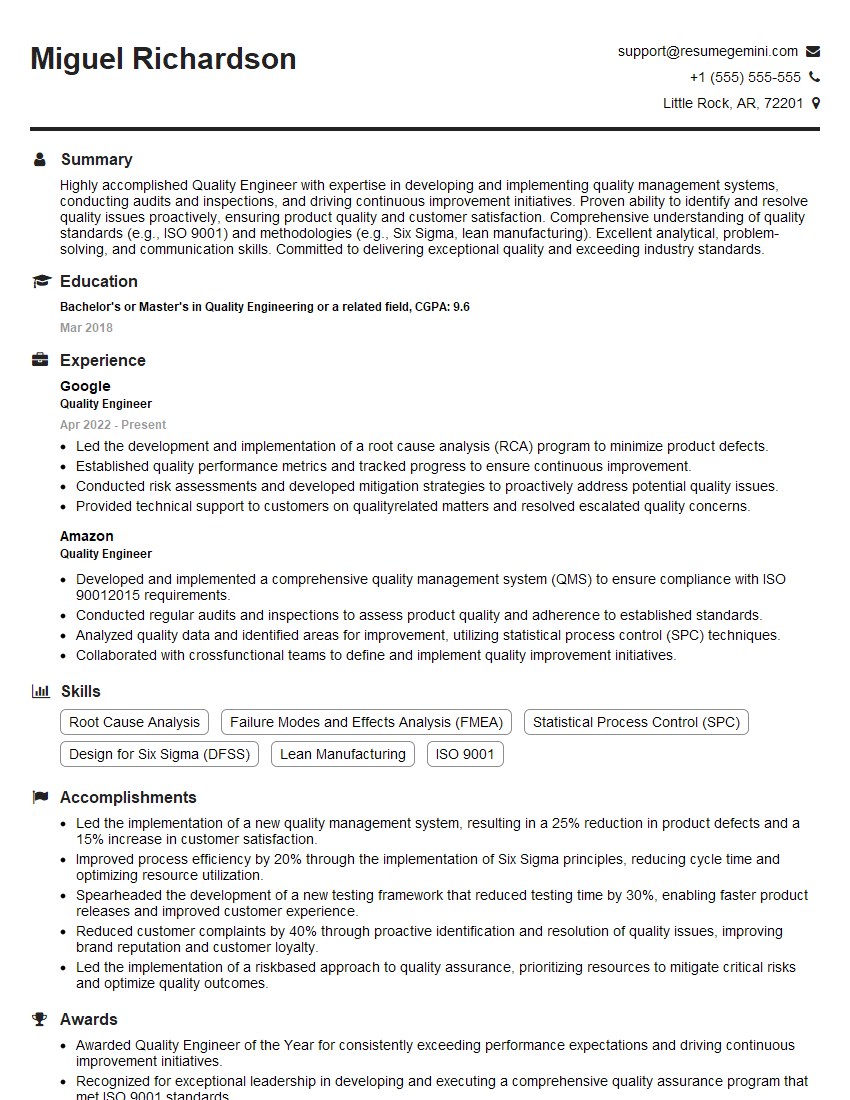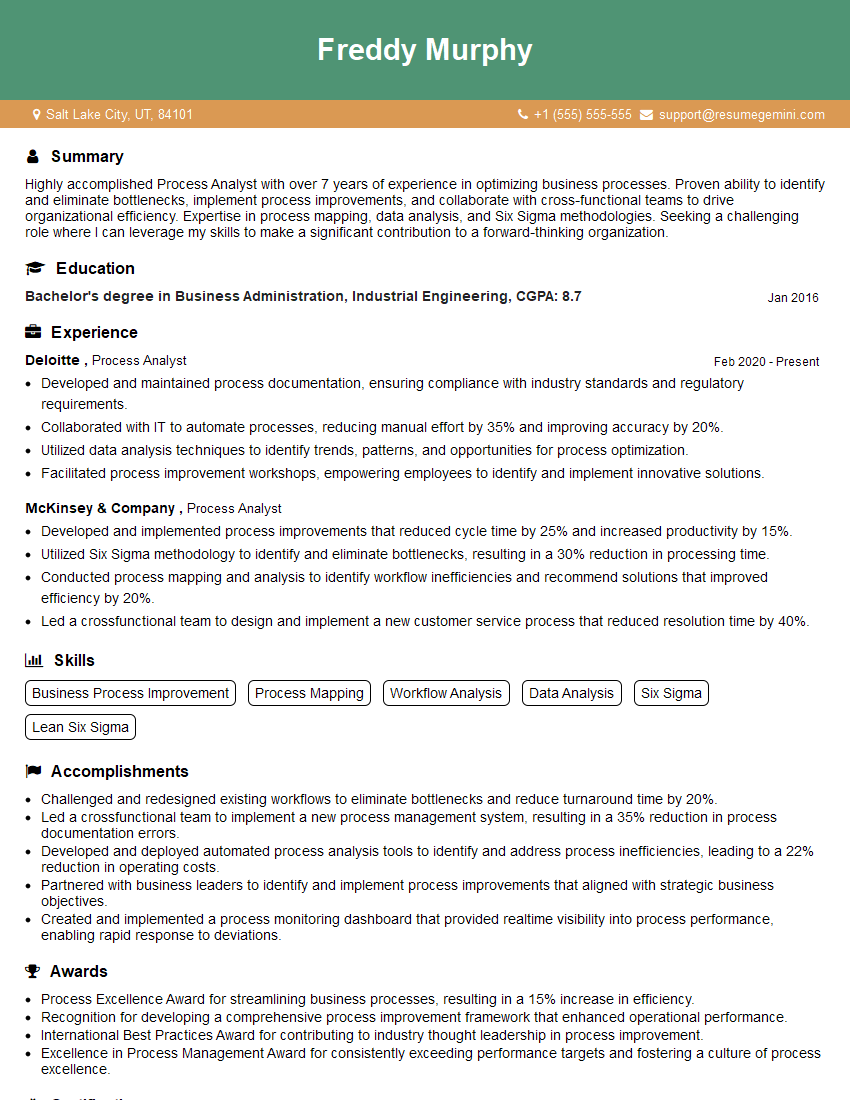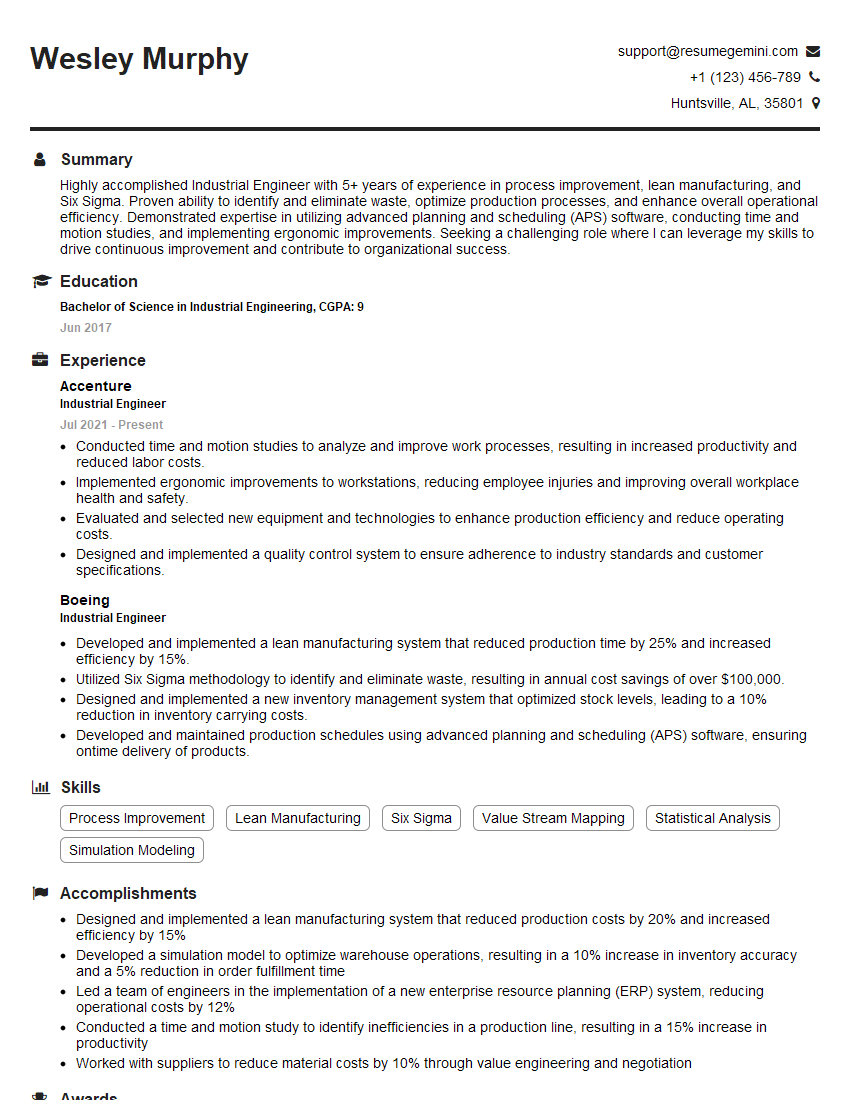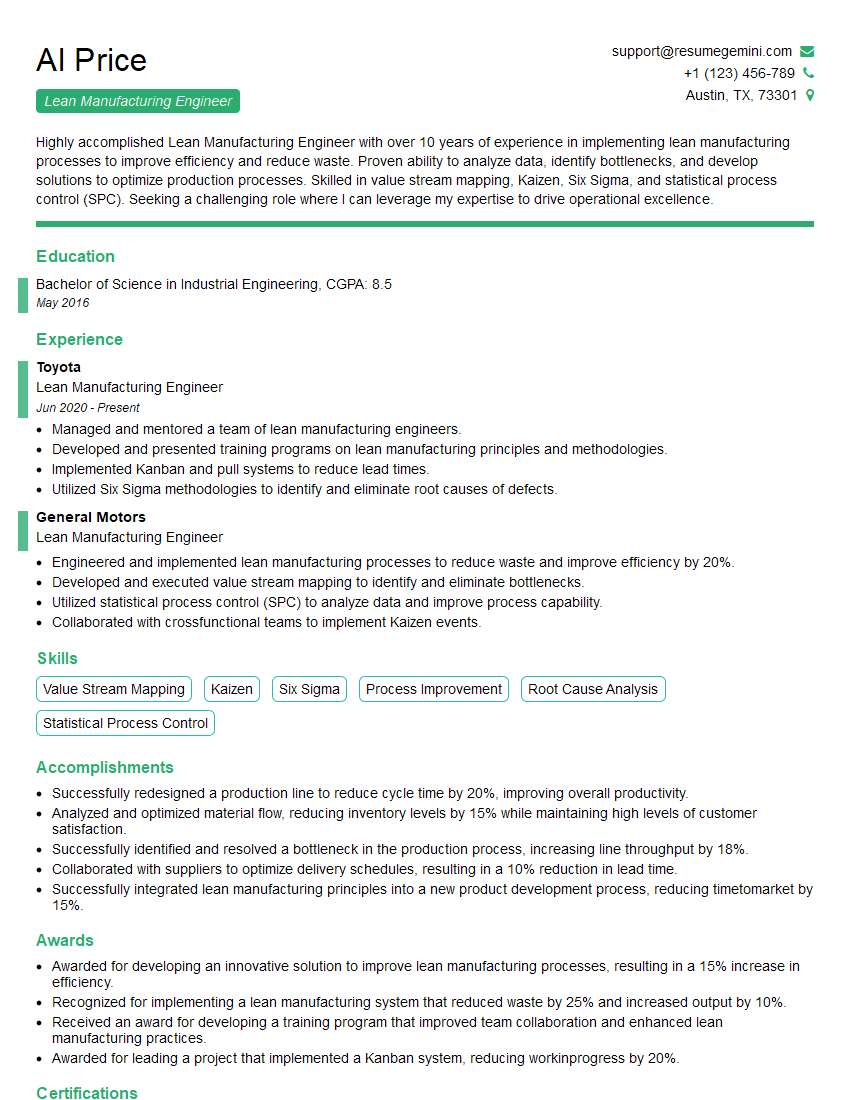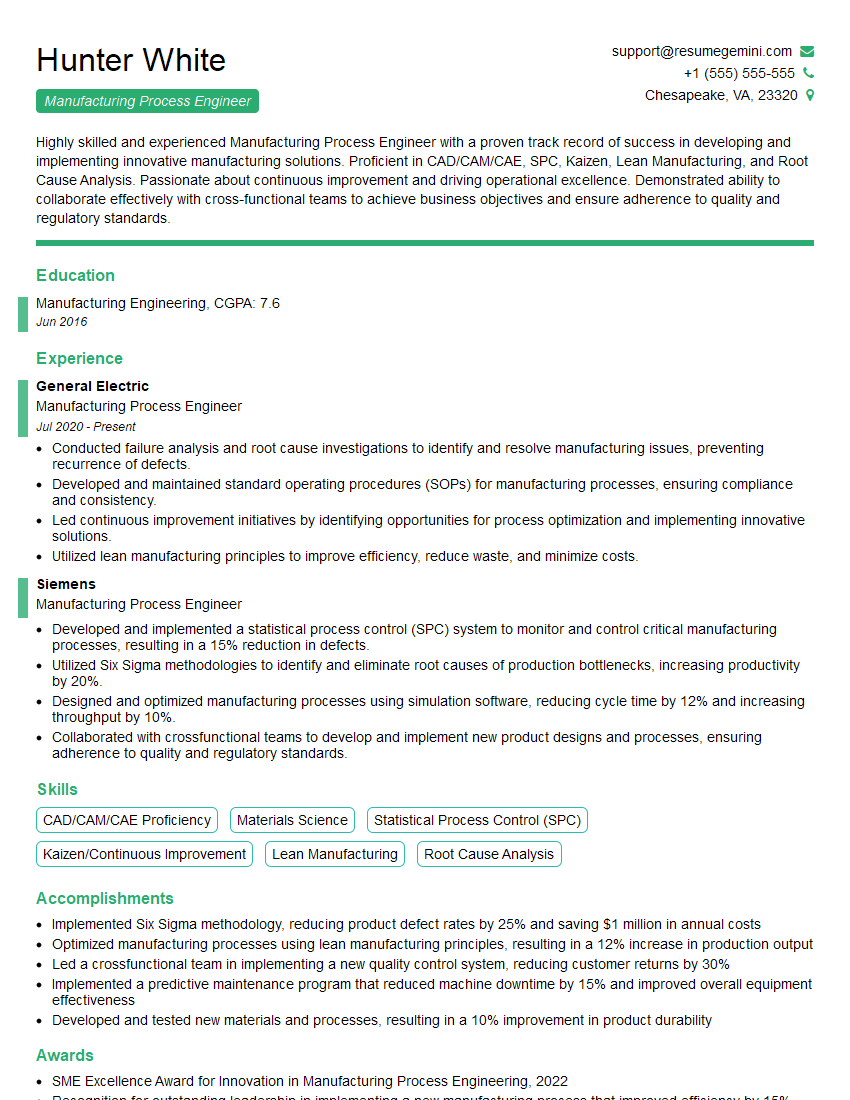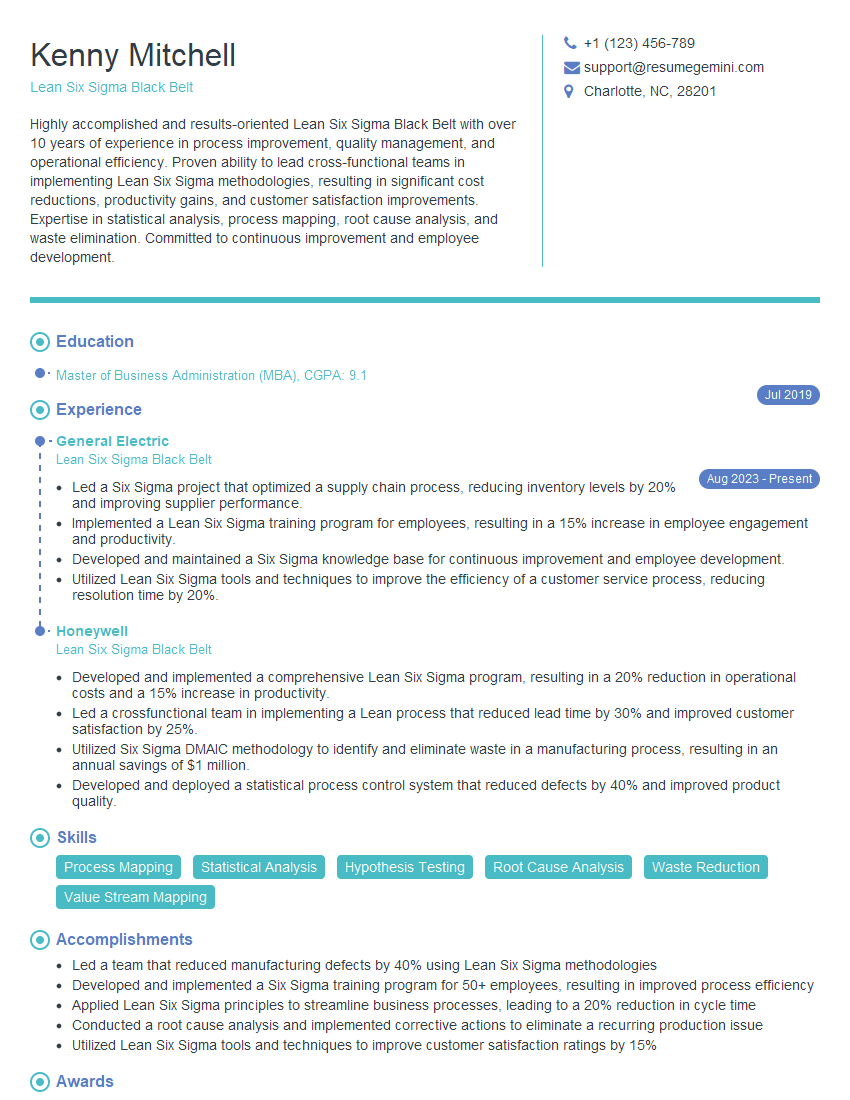Cracking a skill-specific interview, like one for Experience with Lean Manufacturing and Process Improvement, requires understanding the nuances of the role. In this blog, we present the questions you’re most likely to encounter, along with insights into how to answer them effectively. Let’s ensure you’re ready to make a strong impression.
Questions Asked in Experience with Lean Manufacturing and Process Improvement Interview
Q 1. Describe your experience implementing Lean principles in a manufacturing environment.
My experience implementing Lean principles spans several years and diverse manufacturing environments. I’ve consistently focused on eliminating waste and improving efficiency by applying Lean tools and methodologies. For instance, in my previous role at Acme Manufacturing, we tackled significant bottlenecks in our assembly line. Through a combination of Value Stream Mapping (VSM) and Kaizen events, we identified and eliminated excess inventory, reduced lead times by 30%, and improved overall equipment effectiveness (OEE) by 15%. This involved streamlining processes, optimizing workflows, and empowering the team to identify and solve problems directly. Another project involved implementing a Kanban system for managing inventory flow, which dramatically reduced waste and improved predictability in our production schedule.
Q 2. Explain the 5S methodology and how you’ve applied it.
5S is a foundational Lean methodology focused on creating a clean, organized, and efficient workplace. The five S’s are: Seiri (Sort), Seiton (Set in Order), Seiso (Shine), Seiketsu (Standardize), and Shitsuke (Sustain). In a previous project at Beta Manufacturing, we implemented 5S in the warehouse. First, we sorted through all materials, discarding obsolete or unnecessary items (Seiri). Then, we organized the remaining items logically, improving accessibility and reducing search times (Seiton). Next, we cleaned the entire warehouse thoroughly and established regular cleaning schedules (Seiso). We then standardized these cleaning procedures and created visual cues to maintain order (Seiketsu). Finally, we established a system for regular audits and training to ensure the 5S principles were sustained long-term (Shitsuke). The result was a significantly improved working environment, reduced clutter, and improved safety.
Q 3. What is Value Stream Mapping, and how have you used it to identify and eliminate waste?
Value Stream Mapping (VSM) is a powerful Lean tool for visualizing the flow of materials and information in a manufacturing process. It helps identify bottlenecks, waste, and areas for improvement. In my experience, I’ve used VSM extensively to analyze processes and pinpoint areas for optimization. At Gamma Manufacturing, we used VSM to map the entire production process for our flagship product. The map clearly revealed several areas of waste, including excessive transportation, unnecessary inventory, and long lead times. Based on this analysis, we implemented several changes, such as reorganizing the production layout to minimize movement, implementing a pull system to reduce inventory, and improving communication between departments to accelerate the production cycle. This resulted in a significant reduction in lead time and cost.
Q 4. How do you identify and prioritize improvement opportunities?
Identifying and prioritizing improvement opportunities involves a structured approach. I typically use a combination of data analysis, visual management tools, and team input. First, I collect data on key performance indicators (KPIs) such as cycle time, defect rates, and inventory levels. This data helps identify areas with the greatest potential for improvement. Then, I utilize tools like Pareto charts to prioritize issues based on their impact. Team involvement is critical; using brainstorming sessions and 5 Whys analysis helps uncover root causes and generate creative solutions. Finally, I rank opportunities based on their potential impact and feasibility, focusing on quick wins that demonstrate early success and build momentum.
Q 5. Describe your experience with Kaizen events or other rapid improvement initiatives.
I have extensive experience leading and participating in Kaizen events, which are focused, short-term improvement projects aimed at solving specific problems. At Delta Manufacturing, we conducted a Kaizen event to address a recurring bottleneck in the packaging department. Over a 3-day period, a cross-functional team worked together to analyze the process, identify root causes of delays, and implement solutions. This involved redesigning the packaging process, improving workstation layouts, and implementing standardized work. The result was a 20% reduction in packaging time and an improvement in overall efficiency. Similarly, I’ve utilized other rapid improvement methods like Gemba walks to identify issues directly at the source and implement immediate corrective actions.
Q 6. What are the key metrics you use to measure the success of Lean initiatives?
The key metrics I use to measure the success of Lean initiatives vary depending on the specific project, but generally include:
- Lead time reduction: Decreased time from order to delivery.
- Cycle time reduction: Reduced time to complete a process step.
- Inventory reduction: Lower levels of work-in-progress (WIP) and finished goods.
- Defect rate reduction: Fewer errors and improved quality.
- Overall Equipment Effectiveness (OEE): Improved machine utilization and efficiency.
- Cost reduction: Lower production costs and improved profitability.
Q 7. Explain your understanding of different types of waste (Muda) in Lean manufacturing.
Muda, or waste, is a core concept in Lean manufacturing. There are several types of Muda, including:
- Transportation: Unnecessary movement of materials.
- Inventory: Excess stock that ties up capital and space.
- Motion: Unnecessary movements by workers.
- Waiting: Delays in the production process.
- Overproduction: Producing more than is needed.
- Over-processing: Performing unnecessary work steps.
- Defects: Errors that lead to rework or scrap.
- Talent: Underutilizing the skills and knowledge of employees.
Q 8. How do you handle resistance to change when implementing Lean improvements?
Resistance to change is a common hurdle in Lean implementations. It often stems from fear of the unknown, loss of control, or perceived extra work. My approach is multifaceted and focuses on building buy-in from the outset.
- Education and Communication: I start by clearly explaining the why behind the changes – how they’ll improve efficiency, reduce waste, and ultimately benefit the team and the organization. I use clear, simple language, avoiding jargon.
- Involvement and Participation: I actively involve team members in the planning and implementation phases. This gives them ownership and a voice, making them less resistant. We brainstorm solutions together, creating a collaborative environment.
- Pilot Projects and Gradual Implementation: Instead of a massive overhaul, I advocate for pilot projects to demonstrate the success of Lean principles in a smaller scope before scaling up. This reduces risk and builds confidence.
- Addressing Concerns Directly: I create a safe space for team members to express their concerns and address them honestly and transparently. I actively listen and seek to understand their perspectives. Sometimes, this might involve adjusting the implementation plan to accommodate specific needs.
- Celebrating Successes: Regularly acknowledging and celebrating small wins builds momentum and reinforces the positive impact of Lean initiatives, encouraging further participation.
For example, in a previous project involving a shift to Kanban, I faced resistance from a team used to traditional project management methods. By involving them in designing the Kanban board and setting the workflow limits, I addressed their concerns about losing control and fostered a sense of ownership. The pilot project’s success then eased the transition for the rest of the team.
Q 9. Describe your experience with different Lean tools and techniques (e.g., Kanban, Poka-Yoke).
My experience encompasses a wide range of Lean tools and techniques. I’ve successfully applied:
- Kanban: I’ve utilized Kanban to visualize workflow, limit work in progress (WIP), and improve flow in several projects. For instance, in a software development team, we implemented a Kanban board to track tasks, identify bottlenecks, and improve throughput. This led to a 20% reduction in lead time.
- Poka-Yoke (Mistake-Proofing): I’ve implemented Poka-Yoke mechanisms to prevent errors from occurring in the first place. In a manufacturing setting, we designed a simple jig to ensure parts were correctly assembled, eliminating a recurring defect. This drastically reduced rework and scrap.
- 5S (Sort, Set in Order, Shine, Standardize, Sustain): This foundational Lean methodology is integral to any improvement project. I’ve used it to improve workplace organization, reduce waste, and create a safer and more efficient work environment. The improvement in workplace organization directly translates to easier workflow and reduced search times for tools and materials.
- Value Stream Mapping (VSM): I use VSM to visually represent the flow of materials and information, identifying areas of waste and opportunities for improvement. This is a critical step in any Lean project as it clearly maps out the “as is” state and sets the stage for the “to be” state.
- Kaizen Events (Continuous Improvement): I facilitate Kaizen events, bringing teams together to identify and solve problems, often within short, focused time periods. These events foster a culture of continuous improvement.
Q 10. How do you ensure sustainability of Lean improvements after implementation?
Sustaining Lean improvements requires a long-term commitment and a shift in organizational culture. It’s not just about implementing tools; it’s about embedding Lean thinking into everyday operations.
- Standardization: Once improvements are implemented, they must be standardized to ensure consistency and prevent backsliding. This involves creating clear, documented procedures and training employees on the new processes.
- Leadership Support: Sustained Lean initiatives require unwavering support from leadership. Leaders must champion the changes, provide resources, and hold teams accountable.
- Continuous Improvement Culture: A culture of continuous improvement must be fostered, where employees are encouraged to identify and solve problems on an ongoing basis. Regular Kaizen events and other improvement initiatives are key.
- Measurement and Monitoring: Key performance indicators (KPIs) should be established and tracked to monitor the effectiveness of the improvements and identify any areas that require further attention. Regular review meetings and reporting ensure continued tracking and progress.
- Employee Engagement: Engaging employees in the process through training, feedback mechanisms, and recognizing their contributions helps sustain the changes. Creating a sense of ownership is critical.
For example, after implementing a Lean project to reduce lead times in a production process, we established a daily visual management system to track key metrics and hold regular review meetings to discuss progress and address any emerging challenges.
Q 11. What is your experience with Six Sigma methodologies (DMAIC, DMADV)?
I have extensive experience with Six Sigma methodologies, particularly DMAIC (Define, Measure, Analyze, Improve, Control) and DMADV (Define, Measure, Analyze, Design, Verify).
- DMAIC: I’ve used DMAIC to systematically improve existing processes. A recent project involved reducing defects in a packaging process. We followed the DMAIC framework to identify the root cause of the defects, implement corrective actions, and monitor the results. This resulted in a significant reduction in defects and cost savings.
- DMADV: I’ve used DMADV to design new processes or products from the ground up. For example, we used DMADV to design a new assembly line, ensuring it was optimized for efficiency and quality from the start.
Six Sigma and Lean are complementary methodologies. While Lean focuses on eliminating waste, Six Sigma emphasizes reducing variation and improving quality. I often combine aspects of both to achieve optimal results. The combination of tools and methodologies is key to creating effective process improvement.
Q 12. How do you measure the ROI of Lean projects?
Measuring the ROI of Lean projects requires a clear understanding of the costs and benefits. It’s not just about financial gains; it also includes qualitative improvements.
- Cost Reduction: Calculate the reduction in costs due to reduced waste (e.g., material, labor, energy), improved efficiency, and fewer defects.
- Increased Throughput/Productivity: Measure the increase in output or productivity as a result of the Lean improvements.
- Improved Quality: Quantify the reduction in defects or errors and the improvement in customer satisfaction.
- Lead Time Reduction: Measure the reduction in lead time for completing tasks or producing products.
- Inventory Reduction: Calculate the reduction in inventory levels and associated holding costs.
I use a combination of quantitative and qualitative data to calculate the ROI. For instance, in a previous project, we calculated the financial savings from reduced waste and improved throughput, and we also surveyed employees to gauge their satisfaction with the improved work environment. This comprehensive approach gave a complete picture of the project’s impact.
Q 13. Describe a time you failed to implement a Lean improvement. What did you learn?
In one instance, I attempted to implement a new scheduling system without fully considering the impact on the existing team dynamics. The system, while theoretically efficient, didn’t account for the team’s established communication patterns and informal support structures. This led to confusion, decreased morale, and ultimately, a partial rollback of the implementation.
The key learning was the importance of understanding the human side of Lean. While tools and techniques are crucial, successful implementation depends on having buy-in and effective communication. In the future, I will place a higher emphasis on thoroughly understanding and involving the team in the implementation phase of a new system or process.
Q 14. How do you facilitate communication and collaboration within a team during Lean initiatives?
Effective communication and collaboration are vital for successful Lean initiatives. My approach involves:
- Regular Team Meetings: I facilitate regular meetings to keep the team informed, discuss progress, address challenges, and solicit feedback. These meetings use visual aids to facilitate understanding and ensure everyone is on the same page.
- Visual Management: I use visual management tools such as Kanban boards, dashboards, and charts to make information easily accessible and understandable to everyone involved.
- Open Communication Channels: I encourage open communication through various channels, including email, instant messaging, and regular face-to-face interactions.
- Cross-Functional Collaboration: I foster collaboration between different departments or teams to ensure a holistic approach and address interdependencies. This requires clear communication and coordination across teams.
- Active Listening and Feedback: I actively listen to team members’ concerns and feedback and incorporate them into the improvement process. This ensures everyone feels heard and valued.
For example, during a recent project, we used a shared online document to track progress, share ideas, and provide updates. This ensured transparency and facilitated effective communication among geographically dispersed team members.
Q 15. What is your experience with data analysis and its role in Lean improvement?
Data analysis is the backbone of successful Lean improvements. It’s not just about collecting numbers; it’s about using data to identify waste, understand process flows, and measure the effectiveness of implemented changes. In my experience, I leverage various statistical tools and techniques, including:
- Statistical Process Control (SPC): Using control charts to monitor process stability and identify deviations from expected performance. For example, I used SPC to track the defect rate in a packaging line, pinpointing a specific machine setting that was causing increased errors.
- Value Stream Mapping (VSM): Visually representing the entire material and information flow of a process to identify areas of waste and bottlenecks. This involves gathering detailed data on processing time, inventory levels, and transportation times.
- Root Cause Analysis (RCA): Employing tools like the ‘5 Whys’ or Fishbone diagrams to systematically investigate the root causes of problems, not just the symptoms. For example, a high defect rate may be traced to poor training rather than machine malfunction.
- Process Capability Analysis: Assessing the ability of a process to consistently meet specifications. This informs decisions about process improvements and investment in new equipment.
By combining data analysis with Lean principles, we can create a data-driven approach to process improvement, ensuring that changes are effective and sustainable.
Career Expert Tips:
- Ace those interviews! Prepare effectively by reviewing the Top 50 Most Common Interview Questions on ResumeGemini.
- Navigate your job search with confidence! Explore a wide range of Career Tips on ResumeGemini. Learn about common challenges and recommendations to overcome them.
- Craft the perfect resume! Master the Art of Resume Writing with ResumeGemini’s guide. Showcase your unique qualifications and achievements effectively.
- Don’t miss out on holiday savings! Build your dream resume with ResumeGemini’s ATS optimized templates.
Q 16. Explain the concept of Takt time and how it relates to Lean manufacturing.
Takt time is the pace at which a company must produce goods to meet customer demand. It’s calculated by dividing the available production time by the customer demand. Think of it like the heartbeat of a Lean manufacturing system.
Formula: Takt Time = Available Production Time / Customer Demand
For example, if a factory has 8 hours of production time per day (480 minutes) and needs to produce 240 units, the Takt time is 2 minutes per unit (480 minutes / 240 units = 2 minutes/unit). This means every 2 minutes, a unit must be completed to meet customer demand. In Lean, we strive to align all processes to this Takt time, ensuring we produce exactly what’s needed, when it’s needed, without excess inventory or delays. It’s a crucial element for synchronizing production with customer demand and minimizing waste.
Q 17. How do you manage inventory levels using Lean principles?
Managing inventory efficiently is paramount in Lean. The goal is to minimize inventory levels while ensuring sufficient material is available to meet demand. We achieve this through several key Lean principles:
- Just-in-Time (JIT) Inventory: Receiving materials only when needed for production. This reduces storage costs and minimizes the risk of obsolescence. I’ve successfully implemented JIT systems in several organizations, reducing inventory carrying costs by up to 20%.
- Kanban Systems: Using visual signals (cards, lights) to trigger replenishment of materials. This prevents overstocking and improves inventory visibility. This system ensures parts arrive to the production line in a pull system rather than a push system preventing excess inventory.
- 5S Methodology: Organizing the workplace to optimize efficiency and reduce waste. This includes sorting, setting in order, shining, standardizing, and sustaining, which directly influences inventory management by improving flow and eliminating search time.
Effective inventory management requires close collaboration between procurement, production, and sales to accurately forecast demand and maintain optimal stock levels.
Q 18. What are your thoughts on the role of technology in Lean manufacturing?
Technology plays a transformative role in Lean manufacturing. It enables data-driven decision-making, automation of processes, and improved communication across the value stream.
- MES (Manufacturing Execution Systems): Real-time tracking of production performance, enabling quick identification of issues and efficient scheduling.
- Automated Guided Vehicles (AGVs) and Robots: Reducing manual handling and improving efficiency in material handling.
- Digital Twin Technology: Simulating production processes to test and optimize improvements before implementation.
- Predictive Maintenance: Utilizing sensor data to predict equipment failures and schedule maintenance proactively, minimizing downtime.
In my experience, integrating technology strategically enhances Lean initiatives, boosting productivity, quality, and overall efficiency. The key is to select technologies that specifically address existing pain points and align with overall Lean objectives.
Q 19. Describe your understanding of the Toyota Production System (TPS).
The Toyota Production System (TPS) is the foundation of Lean manufacturing. It’s a philosophy focused on eliminating waste and maximizing value for the customer. Two core pillars support TPS:
- Just-in-Time (JIT): Producing goods only when needed, minimizing inventory and waste.
- Jidoka (Autonomation): Building quality into the process by empowering workers to stop the production line when a problem is detected. This prevents defects from propagating further down the line.
Beyond these pillars, TPS emphasizes continuous improvement (Kaizen), respect for people, and a focus on eliminating the seven types of Muda (waste): transportation, inventory, motion, waiting, overproduction, over-processing, and defects. Implementing TPS requires a culture shift towards continuous improvement and employee empowerment. I’ve witnessed firsthand the transformative power of TPS in creating highly efficient and responsive manufacturing environments.
Q 20. How do you address bottlenecks in a manufacturing process using Lean principles?
Addressing bottlenecks requires a systematic approach. My process usually involves:
- Identify the Bottleneck: Use data analysis (VSM, cycle time measurements) to pinpoint the process step limiting overall throughput.
- Analyze the Root Cause: Employ RCA techniques (5 Whys, Fishbone diagrams) to understand why the bottleneck exists. Is it due to equipment limitations, inefficient processes, or lack of training?
- Develop Solutions: Based on the root cause analysis, explore solutions such as:
- Improving Equipment Efficiency: Upgrading machinery, optimizing machine settings.
- Streamlining Processes: Eliminating unnecessary steps, improving workflow.
- Investing in Training: Upskilling employees to improve efficiency and reduce errors.
- Adding Capacity: Investing in additional equipment or personnel if necessary.
- Implement and Monitor: Pilot the solution, track performance, and make adjustments as needed. Use data to measure the effectiveness of the changes.
It’s crucial to focus on the root cause and not just treat the symptoms. A holistic approach is essential for sustainable improvement.
Q 21. How do you involve employees in Lean initiatives?
Employee involvement is critical for successful Lean implementation. It’s not just about management dictating changes; it’s about creating a culture of continuous improvement where everyone feels empowered to contribute. My approach includes:
- Training and Education: Providing employees with thorough training on Lean principles, tools, and techniques. This fosters understanding and buy-in.
- Kaizen Events: Organizing workshops where employees collaboratively identify and solve problems within their areas of expertise.
- Gemba Walks: Regularly visiting the production floor to observe processes firsthand, gather feedback, and engage with employees directly.
- Suggestion Systems: Establishing a system for employees to submit improvement suggestions and providing feedback on their proposals.
- Cross-functional Teams: Involving employees from different departments in improvement initiatives to foster collaboration and shared ownership.
By actively involving employees, you not only get their valuable insights but also create a sense of ownership and commitment to the Lean journey.
Q 22. What are your strengths and weaknesses regarding Lean Manufacturing and Process Improvement?
My strengths lie in my proven ability to effectively lead and implement Lean methodologies, resulting in significant process improvements and cost reductions. I’m adept at identifying waste (Muda), analyzing processes using tools like Value Stream Mapping (VSM) and 5S, and facilitating Kaizen events to drive continuous improvement. I’m also proficient in data analysis, using metrics to track progress and demonstrate ROI. I excel at collaborating with cross-functional teams, fostering a culture of continuous improvement and empowering employees at all levels.
One area I’m actively developing is my proficiency in advanced statistical process control (SPC) techniques. While I possess a foundational understanding and apply basic SPC principles regularly, I’m pursuing further training to enhance my expertise in more complex applications like advanced control charts and capability analysis. This will allow me to further refine process optimization and predictive maintenance strategies.
Q 23. Describe your experience with implementing Lean in a specific industry.
In my previous role at a manufacturing facility producing automotive parts, we implemented Lean principles to significantly reduce lead times and improve overall equipment effectiveness (OEE). We started by conducting a thorough Value Stream Map (VSM) of the entire production process, identifying bottlenecks at various stages, particularly in the assembly line. Through Kaizen events involving frontline workers and management, we eliminated unnecessary steps, optimized workflows, and implemented standardized work procedures. For example, we identified and eliminated redundant material handling steps by reorganizing the warehouse layout and implementing a Kanban system for parts delivery. This resulted in a 20% reduction in lead times and a 15% increase in OEE within six months. We also implemented 5S methodology to improve workplace organization and reduce waste, ultimately leading to a safer and more efficient work environment.
Q 24. What are your salary expectations?
My salary expectations are in the range of $100,000 to $120,000 annually, depending on the specifics of the benefits package and the overall compensation structure. I am open to discussing this further based on a more detailed understanding of the role and responsibilities.
Q 25. What are your career goals?
My career goals involve becoming a recognized leader in Lean Manufacturing and process improvement. I aim to continue expanding my expertise in advanced techniques and methodologies, mentoring and developing teams, and ultimately leading and transforming entire organizations to adopt a Lean culture. I see myself progressing to a senior leadership role within the next 5-7 years where I can strategically influence organizational performance and contribute to long-term success.
Q 26. Why are you interested in this position?
I’m highly interested in this position because it offers a unique opportunity to leverage my Lean expertise in a dynamic and challenging environment. I’m particularly drawn to [Company Name]’s commitment to continuous improvement and its reputation for innovation. The opportunity to contribute to [mention specific project or company goal] resonates deeply with my professional aspirations, and I believe my skills and experience align perfectly with the requirements of this role. I’m confident that I can make a significant contribution to your team’s success.
Q 27. What is your preferred leadership style?
My preferred leadership style is collaborative and empowering. I believe in fostering a team environment where everyone feels valued and empowered to contribute their ideas. I lead by example, actively participating in problem-solving and driving improvements alongside my team. I focus on providing clear direction, setting achievable goals, and providing regular feedback and coaching to support individual and team growth. While I provide direction and guidance, I prioritize empowering team members to take ownership and make decisions, fostering a culture of trust and accountability.
Q 28. How do you handle conflicting priorities?
When faced with conflicting priorities, I employ a structured approach to effectively manage competing demands. I begin by prioritizing tasks based on urgency and importance using a matrix that considers factors such as deadlines, impact on overall goals, and potential risks. I then communicate transparently with stakeholders, explaining the prioritization process and seeking agreement on the chosen approach. I break down complex tasks into smaller, manageable components, delegating where appropriate and ensuring clear accountability. Regular progress monitoring allows me to proactively adjust plans as needed and to prevent potential delays. This systematic approach enables me to effectively manage competing demands and ensure successful completion of critical tasks.
Key Topics to Learn for Your Lean Manufacturing & Process Improvement Interview
- Lean Principles & Philosophies: Understand the core tenets of Lean manufacturing – waste elimination (Muda), value stream mapping, continuous improvement (Kaizen), and the Toyota Production System (TPS). Be prepared to discuss their practical application in diverse manufacturing settings.
- Value Stream Mapping (VSM): Demonstrate your ability to create and interpret VSMs. Practice identifying bottlenecks, non-value-added activities, and opportunities for process optimization. Be ready to discuss real-world examples from your experience.
- Kaizen Events & Rapid Improvement Techniques: Explain your experience with structured problem-solving methodologies like 5S, A3 problem-solving, and PDCA (Plan-Do-Check-Act) cycles. Be prepared to share examples of successful implementations and the quantifiable results achieved.
- Process Improvement Methodologies: Showcase your knowledge of Six Sigma (DMAIC, DMADV), Lean Six Sigma, and other relevant process improvement frameworks. Highlight your practical experience in applying these methodologies to improve efficiency, reduce defects, and enhance overall performance.
- Metrics & Measurement: Discuss key performance indicators (KPIs) used in Lean manufacturing and process improvement. Explain how you’ve used data analysis to track progress, identify areas for improvement, and demonstrate the impact of implemented changes.
- Change Management & Team Leadership: Highlight your skills in leading and motivating teams to embrace change, overcome resistance, and achieve shared goals within a Lean environment. Discuss your approach to fostering collaboration and communication.
- Technological Applications in Lean: Discuss your familiarity with technologies that support Lean initiatives, such as software for data analysis, process simulation, and inventory management. Demonstrate your understanding of how technology can enhance Lean practices.
Next Steps
Mastering Lean Manufacturing and Process Improvement principles is crucial for career advancement in today’s competitive manufacturing landscape. Demonstrating a strong understanding of these concepts will significantly enhance your job prospects. To stand out, create an ATS-friendly resume that effectively highlights your skills and accomplishments. ResumeGemini is a trusted resource that can help you build a professional and impactful resume, ensuring your qualifications are clearly presented to potential employers. Examples of resumes tailored to Lean Manufacturing and Process Improvement experience are available to guide you.
Explore more articles
Users Rating of Our Blogs
Share Your Experience
We value your feedback! Please rate our content and share your thoughts (optional).

